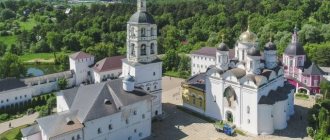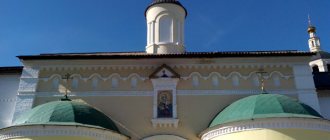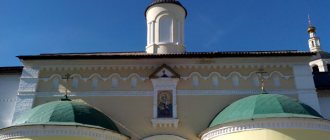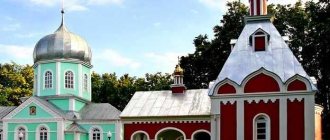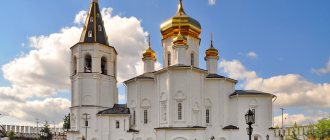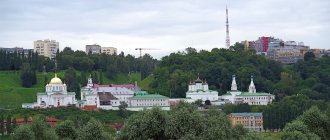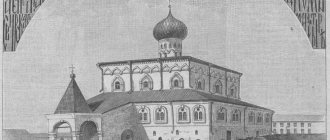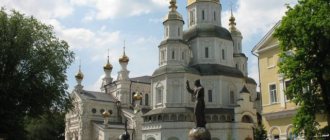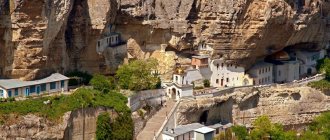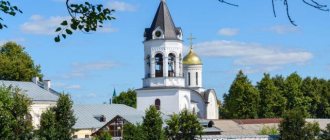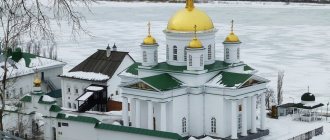The Patriotic War of 1812 was going on. The French behaved badly towards the local population. Villages were completely plundered. The army needed food, and no one cared what would happen to the peasants after that. But not only villages and hamlets were subjected to plunder.
The Frenchman skillfully and tastefully destroyed and plundered religious institutions: monasteries, churches, cathedrals. Everything of any value was removed from the buildings, even if it was simple gilded trinkets.
After looting, buildings were often burned, and if they were made of stone, they were simply shot from cannon.
The refectory of the Borovsky Monastery - construction is almost four hundred years old
What does the Pafnutev Borovsky Monastery have to do with it? But it was just that he lay in the path of the formidable French army. Like the others, it was plundered and destroyed.
By that time, the walls of the monastery had fallen into disrepair, and the monastery itself did not represent the fortress it was in the fifteenth century. And there were less than 30 monks left there.
1675
this year, noblewoman Morozova spent her last days in the casemates of the Borovsky Monastery
In 1675, the noblewoman Morozova spent her last days in the casemates of the Borovsky Monastery. She had great influence at the royal court and supported the Old Believers and Archpriest Avvakum.
Because of this, she came into conflict with Tsar Alexei Mikhailovich and ended up imprisoned in a monastery. Where she was placed in a simple pit and starved to death.
But as we know from history, Napoleon was defeated and driven all the way to Paris. And his fate was sad. But the Borovsky Monastery was rebuilt, and it has survived to this day. Now it is functioning and the Kaluga region can boast of it.
The complex itself belongs to the Kaluga diocese; hundreds and thousands of pilgrims and sufferers visit it. In addition, Elder Blasius conducts his services in the monastery, helping with deeds and advice to everyone.
Venerable Paphnutius of Borovsk, depicted on the icon. Founder of the Holy Paphnutevsky Monastery
The Pafnutiev-Borovsky Monastery is rebuilt, destroyed and rebuilt again
The Holy Paphnutiev Monastery, as it is not difficult to understand from the name, was founded by the Monk Paphnutius of Borovsk in 1444 from the birth of Christ.
Initially, the buildings were built of wood. The reason for choosing the material is simple - there are forests all around, and stone is expensive.
1444
this year the Borovsky Monastery was founded
It is worth recalling that at that time Rus' was heavily taxed by the Tatar-Mongols and there was simply no money for stone chambers.
And the descendants of Genghis Khan loved to plunder Russian lands from time to time, so as to stimulate the payment of tribute. But a stone monastery is difficult to rebuild.
The place for the monastery was chosen wisely. At the confluence of the Isterma River and Protva. Yes, they didn’t just put it, but on a hill.
This way the building was protected from floods, and it was easier to defend the hill from attackers. This was successfully proven when the monastery was surrounded by stone walls.
Photo of the Nativity Cathedral of St. Paphnutevsky Monastery. The relics of St. Paphnutius Borovsky are kept inside the temple.
After the death of Paphnutius, the place of head of the monastery was taken by his disciple, the Monk Joseph of Volotsky. He began to establish new rules in the monastery.
Seeing this, many monks began to be indignant and opposed to the new charter.
As a result, Joseph left the holy monastery and founded his own monastery, called the Joseph-Volokolamsk Monastery.
Icon of St. Joseph of Volotsk, disciple of Paphnutius and founder of the Joseph-Kolomensky Monastery
In 1467 a miraculous event occurred. The old wooden church was dismantled, and in its place a beautiful white stone church was built - the Nativity Cathedral.
Unfortunately, this building has not survived to this day.
1476
this year a white stone Nativity Cathedral was built on the site of the old church
The icon painter Dionysius painted the church. This painting is considered his earliest work, and according to the life of Paphnutius, his teacher, the icon painter Mitrofan, helped him with advice.
The next time they returned to rebuilding the monastery after 117 years. Tsar Fyodor Ioanovich, who came to power, ordered the construction of a new one on the site of the previous temple.
The building of 1586 had five chapters and retained elements of the previous church.
In particular, masonry blocks with paintings by Dionysius and Mitrofan were used. These elements have been preserved and are located in the Andrei Rublev Museum of Ancient Russian Culture and Art in Moscow and the Borovsky branch of the Kaluga Regional Museum of Local Lore.
In the sixteenth century, the monastery was turned into a real fortress.
The area was surrounded by stone walls. And although it is difficult for a modern Russian to imagine this, in the 16th century the Kaluga region was the border land of the Moscow Principality and the Crimean Tatars regularly came there with raids.
Simultaneously with the construction of fortifications, the internal buildings of the Borovsky Monastery were also built. Instead of the old wooden refectory, they erected a new stone one with the Church of the Nativity of Christ.
The use of stone reduced the likelihood of fire, the main enemy of cities in those years. In 1523, a belfry was added to the assembly of monastic buildings. At that time the monastery did not have its own bell tower.
1688
this year the belfry was replaced with a bell tower. The project was sponsored by Prince Konstantin Shcherbatov
To improve the fortification properties of the walls of the Borovsky Monastery, towers were added to them. They rose above the walls and allowed the defenders to more effectively repel enemy attempts to capture the wall or fortify themselves on it. Each tower had its own name.
For example, the design and construction of the Povarennaya, Georgievskaya and Oruzheynaya towers is attributed to the eminent architect Fyodor Kon. By the way, he was involved in the construction of the White City in Moscow.
However, modern archaeologists refute this theory and call the builders of the towers the same people who built the walls and the refectory.
At the end of the sixteenth and beginning of the seventeenth centuries, the Time of Troubles occurred in Russia. In those years, there was a formal civil war, mixed with foreign occupation by the Poles.
The Borovsky Monastery was badly damaged, part of the wall and towers were destroyed. Their restoration was carried out by the architect Trefil Sharutin. It is the remains of the fortifications he restored that have reached our contemporaries.
One of the surviving towers of the Borovsky Monastery
In 1610, the monastery was defended by Prince Mikhail Volkonsky, but the forces were not equal, and the Poles captured the monastery and burned it.
At the beginning of the sixteenth century, fortress walls were often built in incremental steps.
1610
this year the temple was captured and burned by the Poles
Those. It was assumed that the fortress would be defended only on one side, on which the watchtowers were concentrated.
But by the end of the 16th century, such a scheme began to die out and fortresses began to be built taking into account all-round defense.
Monastery architecture
Currently, the architectural ensemble of the Pafnutev-Borovsky Monastery has been restored. Restoration began back in the Soviet years, thanks to which it was possible to preserve a number of buildings from the 16th century and unique frescoes from the 16th–17th centuries.
Amateur panorama of the courtyard of the St. Paphnutievsky Monastery
Cathedral of the Nativity
On a spacious area in the center of the monastery, without hiding its splendor, stands one of the oldest buildings - the five-domed Cathedral of the Nativity of the Blessed Virgin Mary, consecrated in 1589. Two chapels adjoin the southern and northern sides of the temple - in honor of the patrons Fyodor Stratelates and the Great Martyr Irina. The domes of the cathedral are topped with crosses with royal crowns.
Over the course of 400 years, new premises were repeatedly added to the cathedral, for example, in 1837 a refectory was added, in which today there is a chapel in honor of the Monk Paphnutius.
During the restoration carried out in the 1960s, blocks of the very first stone cathedral, built under Paphnutius, were found. The value of the find lies in the partially preserved unique painting of the 15th century, authored by the icon painters Dionysius and Mitrofan. Some handwritten fragments were transferred to the Andrei Rublev Museum.
Through the efforts of restorers, frescoes, tiles and rich icon paintings on the walls of the temple, made in the Byzantine style, were restored.
Inside the temple are kept the relics of Orthodox saints, miraculous icons of the Mother of God, jewelry and, of course, the main shrine - the relics of St. Paphnutius of Borovsky.
Nativity Cathedral, © Sergey Vasilets
Elias Church
The Temple of the Prophet Elijah was built of brick in the 16th century and is outwardly modest - one floor, one dome, simple outlines and small sizes. The temple has two extensions, which were used as a refectory and to accommodate the sick. Each of the buildings was built at different periods of time, as can be seen from the joints on the walls. Next to the church there is an ancient cemetery, where, according to legend, the defenders of the fortress who died in 1610 are buried.
Temple of the Prophet Elijah, © Sergey Kuznetsov
Mitrofan's Church
One of the youngest buildings of the St. Paphnutievsky Monastery is considered to be the Mitrofan Church, built in 1760. The temple is single-domed and one-story, its height reaches 30.5 meters, mainly due to the high basement (basement). The rector's building is adjacent to the church, through which you can get to the temple without going outside.
In one of the chambers of the basement lie the remains of the former abbots of the monastery. Since 1992, the relics of the Chozebite martyrs have been on the throne.
The building was heavily damaged twice: during the War of 1812 and World War II. In 1972, an unexploded shell was found under the roof, which, as it turned out, had been lying there since the Second World War, so sappers had to be called in to continue the repairs.
Mitrofan Church, © Nikolay Tuzhilin
Fortress wall
Initially, the St. Paphnutiev Borovsky Monastery was surrounded by a wooden fence, which was replaced in the 16th–17th centuries by a more serious defensive structure - a brick wall with towers and loopholes. The length of the walls is 673 meters, the covered area is 1.62 hectares. The towers have their own names, purpose and history. There are six in total:
- Povarennaya - stands in the west of the fortress, height is 26 meters, the thickness of the walls at the base is more than three meters. The shape of the tower is similar to St. George's. One of the corners rests on a huge boulder.
- The armory is located on the southeast side, the height is about 26 meters. The design is three-tiered. Each of the tiers can be accessed through a separate entrance: from the courtyard, from the fortress wall, or via an internal staircase.
- Georgievskaya - also known as Znamenskaya, is located on the southeast side. The total height is 33 meters. In ancient times, there was a gate to enter the monastery. The tower is almost square in shape, with a tent-shaped roof topped with a cross.
- Tainitskaya is another rectangular tower, but on the northwestern side, near a large ravine. Height 29 meters. It is believed that it was here that enemy troops entered the fortress in 1610. People gave it another name - the Tower of Treason.
- The round one is one of the oldest (1523) and lowest towers, the height is only 8.5 meters, and the thickness of the walls is 85 centimeters. The name comes from the shape of the tower.
- The Watchtower is a huge and imposing tower in the eastern part of the fortress. Most of the base extends beyond the monastery, with only one corner abutting the wall. In ancient times, from its top there was a view of the entire territory of the fortress.
Monastery walls, © Margarita Kushnirenko
Bell tower
One of the outstanding examples of Russian architecture can confidently be called the bell tower of the 17th century. The 55-meter-high building adjoins one of the walls of the refectory. The white stone walls are decorated with picturesque bas-reliefs, semi-columns at the corners, and high rounded windows. The belfry has five tiers, on one of which there is a working tower clock, albeit with a modern mechanism.
In 1859 the tower had nine bells. Of the old bells, only one remained, now it is in the Kolomna Museum. In 1992, 16 new bells, received as a gift and cast in Moscow, were hung on the belfry of the St. Pafnutevsky Borovsky Monastery.
Inside the bell tower you can see medieval frescoes, including the work of the Savior Not Made by Hands. There is also a museum of Russian icons and an icon and bookstore located here.
Monastery belfry, © Margarita Kushnirenko
Schedule of services of the Pafnutiev-Borovsky Monastery
Borovsky Monastery during the Soviet period
In the post-revolutionary period, many churches and monasteries began to be used for purposes other than their original purpose. Often the premises were given over to warehouses and outbuildings, sometimes to hospitals and schools. Often they were simply destroyed.
The Borovsky Monastery failed to maintain its original status. In 1923, all church belongings were removed from its premises and transferred to museums.
194 white stone blocks were pulled out from the foundation of the monastery, 29 of which retained sixteenth-century paintings.
The buildings of the monastery itself were not destroyed. Due to the presence of high walls, it was made into a colony for criminals, where they worked and were re-educated.
Later, the buildings were given over to a more respectable use - an agricultural technical school began to be located there.
In the 1960s, the monastery complex underwent restoration work. The walls and interior decoration were completely updated. After restoration, the monastery was transferred to the local history museum. It remained in this status until the collapse of the USSR.
Borovsky Monastery at present
After the collapse of the Soviet Union, the Borovsky Monastery almost immediately returned to the Russian Orthodox Church. This happens in 1991.
And literally in a couple of months the monastery begins services for parishioners.
1991
this year the Bobrovsky Monastery was returned to the Russian Orthodox Church
At the beginning of the same year, the Church of St. Elijah was returned to the monastery, and the first services were held here.
After some time, the relics of St. Paphnutius of Borovsk, a particle of which was kept in the Pskov-Pechersk Monastery, are returned to the monastery. The place of their storage is the Nativity Cathedral.
Since 1995, services officially began in the church glorifying the Nativity of the Blessed Virgin Mary in Borovsk. A new iconostasis was placed in it and an altar was built.
A chapel of St. Paphnutius was built next to the temple, and in 1996 bells were installed on the bell tower. In 1997, the monastery ensemble was supplemented by the Church of the Martyr Irene.
Where is it located, address and how to get there from Moscow
It is not surprising that such a place attracts a large number of believers. However, the monastery is not only a religious place, an ancient architectural ensemble, historical buildings and paintings that have survived to this day attract many tourists, and its close location to Moscow (only about 100 km) makes it accessible to both pilgrims and simply connoisseurs of antiquity.
The founder of the monastery is the Monk Paphnutius, a student of Nikita of Serpukhov, whose teacher was Saint Sergius of Radonezh. Rev. grew up Paphnutius, in a God-fearing family, was raised in love and respect for Christian values and as a youth entered the Church of the Intercession of the Mother of God, where he spent over 20 years and turned from a novice into an experienced mentor, accepted the rank of hegumen and began managing the monastery.
Here he accepted the Great Schema, expecting his departure to another world, but was miraculously healed. In 1440, he left the monastery with his disciple, prayed a lot to find a new place for ministry, visited other holy monasteries, until he found territory not far from his former home.
The active participation of the brothers contributed to the beginning of the construction of the temple, and already in 1444 a monastery was founded there, where the monk spent the next 30 years of his life in prayer and instruction of disciples, died and was buried here. In 1547 he was canonized.
Thanks to the personality of the monk, the monastery was often visited by people of high class, for example, Tsars Ivan IV and Mikhail Romanov, the Volkonsky princes, who showed honor and respect to both the temple and the abbot himself, which contributed to the growth of the authority of the monastery, its further development and prosperity.
Famous personalities did not always end up in the monastery of their own free will; for example, the schismatic archpriest Avvakum was twice kept under arrest here, and the noblewoman Morozova was also in the monastery prison.
I saw the monastery and battles; in the Time of Troubles, by order of False Dmitry II and the forces of Jan Sapieha, the monastery was besieged and further plundered, thousands of residents who took refuge behind the holy walls died, and the invasion of Napoleon in 1812 not only led to devastation, but also to partial destruction.
However, the Soviet era turned out to be one of the most disastrous for the monastery, during which the monks managed to be expelled from the holy place (1919), declared a monument, using it for other purposes, and, finally, in 1991, re-consecrated and returned it to the Orthodox Church. churches. Inappropriate use brought the architectural complex almost to the state of ruins; significant restoration work was required.
At the moment, the Borovsky Monastery can boast of ancient buildings from the 16th to 18th centuries, wonderful frescoes and fragments of painting from the 15th century.
Among the architectural objects, the most attractive are the Cathedral of the Nativity of the Virgin Mary, the Refectory, the Temple of Elijah the Prophet, the Funeral Building, and the Western fraternal cells.
A believer will want to get acquainted with the shrines stored here - a particle of the relics of St. Paphnutius, the Iveron Icon of the Mother of God, as well as the relics of saints (Prince Vladimir and the Blessed Matrona of Moscow, St. Seraphim of Sarov, the Elders of Optina and others).
Regardless of the purpose of travel, religious or tourist, the visitor will certainly be interested in the Museum of Russian Icons, which presents the history of the monastery itself and icon-painting traditions in general.
Father Vlasiy receives at the Borovsky Monastery: official website, how to get there and how to sign up
The life of a modern person passes in a constant routine and worries about tomorrow. The state of affairs is truly not conducive to idleness.
But it is impossible to always live at this pace and is harmful to health, especially mental health.
People periodically need to talk out and share their worries with someone.
Elder Blasius, healer of the souls of his parishioners. Receives all those who suffer within the walls of the Borovsky Monastery.
Usually friends and relatives act as listeners, but it often happens that there are no relatives nearby, and sometimes you want to talk to a stranger.
Then you need to choose your interlocutor wisely.
See also the article How to get to Elder Ily Nozdrin in Peredelkino
Father Vlasiy, a priest from the Borovsky Monastery, is one of the best options. He will listen to your troubles and give useful advice or point you in the right direction.
Vlasiy himself also lived a difficult life. Father Blasius wandered and was once seriously wounded while defending his monastery from robbers.
Holy Elder
Many believers come to the Borovsky Monastery in the hope of the help of the elder - the local confessor, Father Blasius. They say that this person is able to help with family troubles and health problems. Many believe him and strive to go to confession.
We failed to see this enlightened man. Yes, it’s not so simple: many people come to see Father Vlasiy for advice and consolation. And often people wait more than one day for their turn.
They also say that it was he who became the prototype of Father Anatoly from Pavel Lungin’s film “The Island”.
